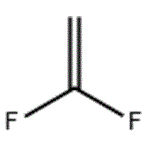Vinylidene fluoride is a colorless gas. Faint
ethereal odor. Shipped as a liquefied compressed gas.
Colorless gas; faint ethereal odor. Slightly soluble in water; soluble in alcohol
and ether.
1,1-Difluoroethylene is used in the manufacture of polyvinylidene
fluoride for its use as a thermal, chemical, and
ultraviolet light–resistant agent, and as an anticorrosive agent.
The monofilament form is used as filter cloth in the pulp and
paper industry. Due to its high melting temperature, it can be
used as an insulator. Some of its copolymers are used for their
heat- and moisture-resistant properties, primarily in industrial,
aerospace, and automotive applications.
Polymers and copolymers, chemical intermediate.
ChEBI: Vinylidene fluoride is an organofluorine compound and an olefinic compound.
1,1-DIFLUOROETHYLENE (or vinylidene fluoride) is a colorless gas which is flammable in the ranges of 5.5 to 21%. 1,1-DIFLUOROETHYLENE is toxic by inhalation and contact. 1,1-DIFLUOROETHYLENE is slightly soluble in water and soluble in alcohol and ether. Under prolonged exposure to fire or intense heat the containers may rupture violently and rocket.
1,1-DIFLUOROETHYLENE is sensitive to heat. 1,1-DIFLUOROETHYLENE is incompatible with oxidizers. 1,1-DIFLUOROETHYLENE can react violently with hydrogen chloride. Alkyl boron and alkyl hyponitrite compounds initiate polymerization. 1,1-DIFLUOROETHYLENE will form peroxides on exposure to pure oxygen. .
Vapors may cause dizziness or asphyxiation without warning. Some may be toxic if inhaled at high concentrations. Contact with gas or liquefied gas may cause burns, severe injury and/or frostbite. Fire may produce irritating and/or toxic gases.
EXTREMELY FLAMMABLE. Will be easily ignited by heat, sparks or flames. Will form explosive mixtures with air. Silane will ignite spontaneously in air. May polymerize explosively when heated or involved in a fire. Vapors from liquefied gas are initially heavier than air and spread along ground. Vapors may travel to source of ignition and flash back. Cylinders exposed to fire may vent and release flammable gas through pressure relief devices. Containers may explode when heated. Ruptured cylinders may rocket.
Suspected carcinogen
with experimental neoplastigenic data.
Mildly toxic by inhalation. Mutation data
reported. A very dangerous fire hazard when
exposed to heat, flame, or oxidzers.
Explosive in the form of vapor when
exposed to heat or flame. Violent reaction
with hydrogen chloride when heated under
pressure. To fight fire, stop flow of gas.
When heated to decomposition it emits
toxic fumes of F-. See also FLUORIDES.
Vinylidene fluoride is used in the
formulation of many polymers and copolymers, such as
chlorotrifluoroethylene-vinylidene fluoride (Kel F),
perfluoropropylene-vinylidene fluoride (Viton, Fluorel);
polyvinylidene fluoride; and hexafluoropropylene-tetra-fluoroethylene-
vinylidene fluoride; elastomeric copolymers. It is
also used as a chemical intermediate in organic synthesis.
NIOSH has estimated 32,000 workers are exposed annually.
Oxidative metabolism of 1,1-Difluoroethylene is mediated by
the hepatic microsomal monooxygenase to form epoxide and
the inactivation of hemeprotein.
UN1959 Vinylidene fluoride shipped as
1,1-Difluoroethylene or Refrigerant gas R-1132a, Hazard
Class: 2.1; Labels: 2.1-Flammable gas. Cylinders must be
transported in a secure upright position, in a well-ventilated
truck. Protect cylinder and labels from physical damage.
The owner of the compressed gas cylinder is the only entity
allowed by federal law (49CFR) to transport and refill
them. It is a violation of transportation regulations to refill
compressed gas cylinders without the express written permission
of the owner.
1,1-Difluoroethylene is a colorless gas. It is slightly soluble in
water, but soluble in organic solvents such as alcohol and
ether. Its boiling point is -85°C, melting point is -144°C,
specific gravity is 0.617 g cm-3, and vapor pressure is
3.0×104 mm Hg. Its octane/water partition coefficient is 1.24
and Henry’s law constant is 0.4 atm-m3 mol-1.
Production and use of 1,1-Difluoroethylene result in its
release to the environment through various waste streams. It
has medium mobility in soil and degrades in soil. It volatilizes
from the contaminated water. Aquatic bioconcentration and
adsorption to sediment are not very significant. As a gas form in
the atmosphere, it reacts with photochemically produced
hydroxyl radicals and degrades.
idizers (chlorates, nitrates, peroxides,
permanganates, perchlorates, chlorine, bromine, fluorine,
etc.); contact may cause fires or explosions. Keep away
from alkaline materials, strong bases, strong acids, oxoacids,
epoxides, aluminum chloride. Capable of forming
unstable peroxides, which can cause explosive polymerization.
It can re act violently with hydrogen chloride. Alkyl
boron and alkyl hyponitrite compounds initiate polymerization.
It will form peroxides on exposure to pure oxygen.
May accumulate static electricity, and cause ignition of its
vapors.
The current ITSL for vinylidene fluoride (30 μg/m3) has a justification (attached) dated November 6, 2003.
Return refillable compressed
gas cylinders to supplier.


